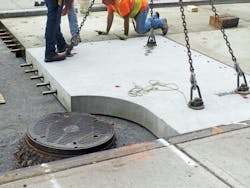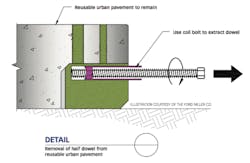Utility player
Roads are a critical part of our everyday lives. Some lead us to family, some—like mountain passes—take our breath away and others serve more mundane purposes, like getting us around town for our weekend errands.
No matter what the purpose, today’s network of more than 2.68 million miles of paved roads in the U.S. are never more appreciated than when they are down for maintenance. Road construction adds time and frustration to motorists’ days, and the longer the work takes, the more it costs taxpayers. As a result, departments of transportation and innovative manufacturers are always on the lookout for ways to lessen the burden. Cities in particular are seeking better ways to repair pavement penetrations that are frequently made to repair utilities under city streets and urban arterials. One recent innovation, reusable urban pavement, or RUP, offers a way to speed up repair while reducing costs and restoring the pavement to its original functionality and aesthetics.
By the slab
The RUP concept is based on another system that has been around for much longer—jointed precast concrete paving slabs. These slabs have been used in more than 20 states across the U.S.—most extensively in California, New York, New Jersey and Illinois.
Jointed precast concrete paving slabs can be used for a wide array of road projects such as highways, intersections, exit ramps, horizontal curves, heavily skewed bridge approach slabs, airport runways and taxiways, and more. The system reduces construction time by using a prefabricated, fully cured concrete slab manufactured off-site in controlled conditions to repair a roadway or extend its service life. One major benefit of installing precast pavement is that long-lasting, permanent repairs can be made during overnight work windows—in as little as five hours—minimizing traffic delays. Additionally, long-term pavement repair costs are reduced because such repairs are expected to last 40 or more years.
The process starts with surveying the jobsite, so shop drawings for the new panels can be prepared. Once drawings are approved, the precaster casts the slabs, storing them until the contractor is ready for installation.
To install the slabs, crews saw cut and remove a predetermined section of the roadway during a period of low traffic, usually at night. Removal is limited to the area that will be replaced during that shift. Once the existing pavement has been removed, the base is prepared to receive the slabs, dowels are drilled and anchored in adjacent existing pavement at pre-determined locations, and new, typically custom-built slabs are installed to precisely fit the repair area. Installation is completed by installing bedding and dowel grout to fully support the slabs and provide load transfer from slab to slab. Using this method, crews can replace sections during off-peak hours and reopen the lanes—which are drivable almost immediately following installation—before traffic intensifies.
Jointed precast concrete can be custom made to fit pretty much any space. Photo courtesy of NYC Department of Design and Construction.
The super paver
Through years of testing and implementation, jointed precast paving systems have consistently improved, but the RUP system offers an entirely new solution to an issue that was previously unsolvable by any other pavement system.
Underneath most urban roads, there is a labyrinth of utilities such as water, gas and sewer that consistently require repairs, replacements or upgrades. By using RUP, city maintenance workers can remove a section of the RUP to create access, complete the utility repair and replace the same precast paving slab. This saves time and reduces the cost currently required for new pavement materials. It also ensures the road doesn’t become a rough driving patch for commuters.
Crews cut through the dowels around the perimeter of the slabs so that they can be removed, providing access to utilities below. While utilities are repaired, crews remove the half dowels still residing in the surrounding pavement so that new, full-length dowels can be epoxy-anchored in place. After utilities are repaired, the cleaned-up precast units are replaced and the pavement is restored to its original condition.
The Fort Miller Co. in Schuylerville, N.Y., has developed the Super-Paver System, which uses its proprietary hollow dowel instead of a typical solid steel dowel to connect the slabs together. This allows dowels to be removed from the pavement as needed.
“A nut is welded to each end of the pipe dowel,” said Peter Smith, P.E., vice president of market development and product engineering for Fort Miller. “You thread a long extraction bolt into the nut at the end of the cut-off dowel and keep turning it against the concrete behind it. That half dowel that’s left in there gets extracted in the process.”
A crewman works with the Super-Paver System hollow dowel. Photo courtesy of the Ford Miller Co.
New York City tested
Any new product requires a champion to encourage its use. When it comes to RUP in New York City, this role is being played by Dino Ng, P.E., associate commissioner of infrastructure design for the Department of Design and Construction. Ng is familiar with Fort Miller’s standard jointed precast concrete paving slab system and its traffic mitigation advantages from previous projects. One of the questions Ng had was, “How do you deal with that if you want to use it on a city street?” This led the two groups to start working through the issues each side was facing and how to resolve them, eventually leading to the development of RUP.
“Dino was instrumental in pushing us to develop this product,” Smith said. “He was a guy with a need, and we as a precaster responded to that need. Simple as that.”
From that point, all that was left was to give the slabs a real-life test. The perfect test site was located at the Broadway Junction area, near the border of Brooklyn and Queens on the city’s southeast side.
“This particular area has a high concentration of bus intermodal transfer,” Ng said. “There’s a subway station there. There are multiple buses that stop in this area. So it’s a heavily trafficked area, both for pedestrians as well as for vehicular traffic.”
The project was not initially slated for RUP, but Ng began to wonder how many lanes of traffic could be closed without creating chaos in the neighborhood and how to accelerate the construction. Broadway Junction proved to be the ideal location because of the heavy traffic and the anticipated future need to access utilities under the roadway. The area is split by a median, so the DDC was able to close off one roadway at a time. Installation was completed in June 2016.
One challenge that had to be overcome was delivering the equipment and slabs into a congested area of “the city that never sleeps.”
“Broadway Junction is a congested neighborhood with heavy traffic,” said Dan Moellman, P.E., senior project manager for Fort Miller. “Slab deliveries were a challenge every day. The logistics are very difficult for bringing materials and equipment to the jobsite.”
Installation included 167 slabs, which are 8 ft by 12 ft, 10 in. thick and reinforced with two layers of No. 4 epoxy-coated rebar. Most slabs weigh 16,000 lb and some have blockouts for cast-in-place field closure pours that were used around existing utilities.
One major challenge for Fort Miller was to design the slabs to match the pavement elevations along new curb sections, including ADA-compliant curb ramps at 11 locations. The system even got an unexpected trial when an installed panel had to be removed to fix an issue with a utility below. In the end, both parties were pleased with the result.
Next up
Fort Miller is eyeing a number of future projects based on the success of the New York City trial run. One, a large job in Richmond, Ind., begins in January 2017.
“They’re going to be installing RUP for exactly the same reason,” Smith said. “There are tons of utilities under the pavement and they want the capability of going in, repairing the utilities and then replacing those same slabs. So, the first job was Broadway Junction to kick the tires, and now Richmond, Ind., and that’s going to be a full-sized production project.”
The company also is doing a second RUP project in New York City with the DDC. Bus pads at 17 sites throughout Staten Island and Brooklyn will be replaced with RUP slabs.
“It gives you a new way of attacking these problems in an urban environment,” Moellman said. “This job in Richmond is going to be significant. They are planning for over 1,500 slabs to go in the roadway there, so it’s really an order of magnitude bigger than what we’ve done with this product before.”
From emerging to everyday
Having overseen the first installation of RUP panels in New York City, Ng is bullish on the future of the system. In addition to the benefit of being reusable, he likes the potential of laying the slabs back down temporarily if the work is not completed the same day so that traffic can still access the road during peak hours.
“In this position, I come across a lot of materials and processes people want the city to use,” he said. “I always come in with an open eye and say, ‘What can you do for me? Forget about the cost for a moment.’
“I know a lot of people worry about how much things cost. But if it solves a problem . . . like if I can eliminate potholes from New York City, how much money do I save? How many lawsuits do we avoid? Things like that. Initial cost is one small part of everything you look at. We need to look at problem solving, safety issues and lots of other things.”
It’s that perspective—and the intrinsic benefits built into the system—that Fort Miller and other precasters feel will elevate RUP from an emerging product into an everyday solution for urban roadway repairs.



